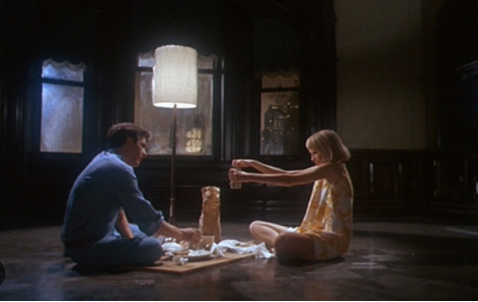“They had the coffee and cake in the kitchen, Mrs. Castevet refusing to let Rosemary disturb the living-room on her account. ‘Listen, Rosemary,’ she said, swallowing cake and coffee at once,
I’ve got a two-inch-thick sirloin steak sitting defrosting right this minute […] Why don’t you and Guy come over and have supper with us tonight, what do you say? – Part One, Chapter Four
Isn’t this inviting? How often does food, either an abundance or lack thereof, mark the beginning of an innocent hero or heroine’s journey to cross over to the dark side?
Time and time again at the heart of the Gothic lies an unsuspecting female protagonist, beckoning readers to follow her on an odyssey of malevolence, betrayal and hardship. Such is the story of Ira Levin’s Rosemary’s Baby (1967), in which a young woman is tricked, abused and manipulated into bearing a terrible secret. A masterpiece of modern Gothic literature, this novel exemplifies the most intimate fears of betrayal, contamination of the body and oppression by potent forces of evil. And food guides us, giving us the crumbs to follow, revealing what lurks in the shadows of neighbourly politeness and social pleasantry.

It’s 1965, and newlyweds Rosemary and Guy Woodhouse have taken a beautiful apartment at the Bramford in a deal that is too good to be true. It’s not like they weren’t warned though; their old friend Hutch tells them over lunch that the building was also ‘where the Trench sisters performed their little dietary experiments…’ (Part One, Chapter Two). The Trench sisters were two Victorian cannibals who cooked and ate young children, and are now said to haunt the apartment building, where witchcraft is rife. This unsavoury piece of information does cause Rosemary to hesitate over her melon dish starter, but it doesn’t discourage her from wanting to move into the new place, driven by the desire to start a family with Guy, perhaps due to not having strong ties to her own.

The Woodhouses’ eccentric old neighbours, Roman and Minnie Castevet, make themselves a daily feature in the couple’s lives soon after they move in, and food is their point of entry. Not-so-tasty offerings become a recurring excuse to worm their way in, and the door is opened to them. After all, why wouldn’t Rosemary trust a friendly face and dishes of homemade food? And yet, Rosemary’s thoughts about her own husband set the tone for all the horror to come: ‘He was an actor; could anyone know when an actor was true and not acting?’ (Part One, Chapter Nine). Guy, arguably her real enemy, right beside her all along, arouses that sense of the Uncanny in the reader: that which is unfamiliar in the familiar. But it is a dessert – the chocolate mousse Minnie brings straight to her door in a seemingly sweet gesture – that gives us an insight into exactly how Guy controls Rosemary and ultimately betrays her trust:
‘The mousse was excellent, but it had a chalky undertaste that reminded Rosemary of blackboards and grade school. Guy tried but could find no ‘undertaste’ at all, chalky or otherwise. Rosemary put her spoon down after two swallows. Guy said, ‘Aren’t you going to finish it? That’s silly honey; there’s no ‘undertaste […] eat it.’” – Part One, Chapter Eight

Guy, initially a struggling actor, gains popularity and abandons Rosemary, leaving her to take refuge in the company of the other women in the apartment block. These women gather in domestic areas of the home like the kitchen, and a distinction is drawn between men and women, husbands and wives. The kitchen, part of the female domestic sphere, is typically a site of trust and as such the food produced is, by default, considered nutritious by Rosemary initially. This renders her open and vulnerable to unspeakable monstrosities – and the insidious witchcraft of her neighbours, who cast their spells through food.
The success of Rosemary’s Baby shows how we are still haunted and fascinated by ideas about witchcraft, inherited from previous centuries. Modern culture has its own use for witches now, particularly in expressing the role of women in society. Minnie’s ‘miniature greenhouse in the kitchen’ (Part One, Chapter Three), for everyone to see, is evil hiding in plain sight. This is a recurring theme in the other Gothic novels; from Jane Eyre by Charlotte Brontë to Rebecca by Daphne du Maurier the real dangers are in these women’s own home, often right beside them.
A version of this article was first published on 20/10/2021 as part of wider research here.
